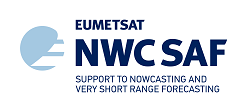South Africa, 18.01.2022. Solution
Analysis >>
We make an analysis here of how NWCSAF products provide us helpful information for the nowcasting, and help us to update the prognosis with up-to-the-minute information.
Please remember that all these products can be available for the forecaster 10/15 minutes after the satellite images are produced!
Humidity and Instability product (iSHAI):
The iSHAI “total precipitable water loop” (iSHAI tpw Loop) defines a “moisture front” with water values > 30 mm, extending from South Botswana to the South African Indian Ocean coast in the Southeast. Moisture is smaller on both sides of this front. The front moves slowly Northeast throughout the day. Moisture maximum values are located in South Botswana and in the Indian Ocean, with > 40 mm. Convection starts around 1000Z throughout this “moisture front”, and extends up to the night.
The “difference with the ECMWF model for the total precipitable water loop” (iSHAI difftpw Loop) shows slightly higher moisture values in iSHAI observation (shown in red) in the first few hours of the night (in which even a few convective cells develop in South Botswana), but later on in general, there are lower moisture values (shown in blue) in iSHAI observation with respect to the forecast ECMWF values.
Considering the iSHAI “water content loops for the different layers”: boundary (iSHAI bl Loop), medium (iSHAI ml Loop), and high layer (iSHAI hl Loop), in general over land moisture is related to the medium layer. Due to the deep convection, moisture grows progressively throughout the day in the high layer. In contrast over the ocean moisture is mostly related to the low layer.
Considering the iSHAI “Instability indices (LI - iSHAI li Loop, K - iSHAI ki Loop, Showalter - iSHAI shw Loop)”, instability is very clear throughout the whole day in “K index” in all Botswana and central South Africa, and shows smaller values in “LI and Showalter Index” (however both defining more concretely the area most affected by convection).
Considering the difference of ISHAI indices with those of the ECMWF model (iSHAI diffli Loop, iSHAI diffki Loop, iSHAI diffshw Loop), in general iSHAI product shows less instability in South Africa and more instability in Botswana with respect to the ECMWF model values.
Considering also the IASI instability product for 0700Z (proxy for the coming MTG-IRS instability product), it shows more instability than the one defined by ECMWF model in central areas of South Africa and North Botswana.
Cloud products (Cloud type, CTTH Cloud Top height):
“CT/Cloud top loop” (CT Loop) and “CTTH/Cloud top height loop” (CTTH Loop) show the evolution of the convective clouds related to the “moisture front” throughout the day in both Botswana and South Africa. Convection starts around 1000Z and reaches its maximum around 1800Z. Cloud top heights reach between 12 and 15 km.
Precipitation products (CRR, CRRPh Convection intensity):
In both products (older CRR Loop, and newer CRRPh Loop based on physical properties), precipitation occurs since 1100Z throughout the whole “moisture front”, but later on since 1400Z all precipitation converges into two big cells located in the frontier between Botswana and South Africa, and in the South African Indian coast. The first cell degrades since 2000Z while the second one lasts until the midnight.
Considering precipitation quantities, as expected, the older CRR product shows smaller precipitation values. Although the maxima in both products can reach values over 50 mm/h, the number of pixels in which these high values are reached is much higher in the newer CRRPh product.
Convection products (Convection Initiation CI, Rapidly Developing Thunderstorms RDT):
The loops for the “Convection initiation” product (CI Loop, probability of a cloudy pixel to become a thunderstorm in the following 30 minutes) provide little information on where new convective cells are going to develop in the “moisture front” we are studying, although it does in other African regions affected by convection.
Considering the loops for the “Rapidly Developing Thunderstorm” product (RDT Loop), they detect rather well the convective cells developing inside the “moisture front” throughout the day. Instead they detect worse the merging of these cells in the second part of the day in the two bigger cells located in the frontier between Botswana and South Africa, and in the South African Indian coast. In both cases, the cells are only seen when smaller cells detected in the vicinity disappear.
Wind product (High Resolution Winds HRW):
The loops for the “High Resolution Winds” product (HRW Loop) detect at high levels the general Southwest flow with which the convection in the “moisture front” moves. A change to a Southern flow is also seen in more Eastern areas, and to a Southeast flow in more Northern areas. Considering the wind at different levels, some eastwards wind shear can be seen at lower levels ahead of the convective region, which can contribute to the convection.
Final discussion >>
Some questions:
- Are you currently using NWCSAF products in your forecasting tasks?
- If not, do you think NWCSAF products can be useful for your tasks as operational forecaster?
- Do you know the way you can obtain these products?
Some options:
* ADAGUC viewer
https://www.nwcsaf.org/web/guest/nwcsaf-view-on-adaguc
* NWCSAF outputs by SWIFT project for Northwest, Northeast and Central Africa https://science.ncas.ac.uk/swift/resources/summary/529%2C518%2C607%2C780%2C1622/0/0
https://science.ncas.ac.uk/swift/resources/summary/356%2C605%2C358%2C406%2C754/0/0
https://science.ncas.ac.uk/swift/resources/summary/429%2C612%2C483%2C767%2C1623/0/0
